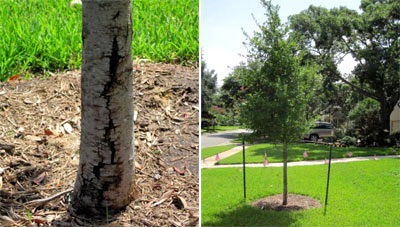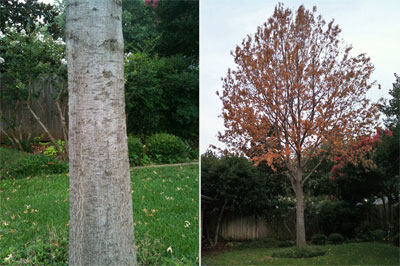Question and Answer – August 2012
Each month Neil chooses 5 to 7 questions of the widest reader interest to answer here in e-gardens. Only questions that are accompanied by photos can be used in this visual medium. If you don’t have a photo, Neil invites you to call his radio programs. Please, no plant ID questions here, as they are usually of interest only to the person sending the photo. Here are this month’s questions.
Question: What would have happened to the trunk of my fig tree? It has done very well until recently. Could it be overwatering from the neighbor’s yard, or is there a chance it was weedkiller applied by our lawn service two weeks ago? What about cotton root rot? S.B., no city given.

Answer: This is none of the three things you mentioned. In all three cases, all of the plant would be affected uniformly. This is only impacting the one branch. My guess is that it is some kind of injury to that branch. It certainly looks like the rest of the plant is healthy and vigorous. Sit tight. All that new growth may not begin to bear fruit for a year or two, since it’s so strongly vegetative. Prune out the dead wood whenever you wish.
Question: What are these small spots on my crape myrtle? It’s a white variety that’s as tall as my house. I don’t want these to take over. S.L., no city given.
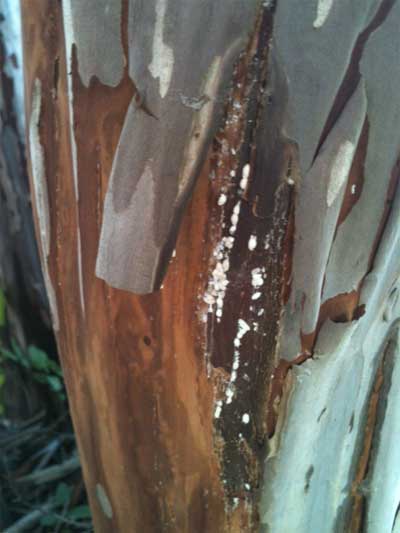
Answer: These are the crape myrtle scale that has sprung up in the North Dallas area over the past 8 years. Here is a link to the most current information on it from Dr. Mike Merchant with Texas A&M.
http://crapemyrtletrails.org/pest.html
Question: What could be wrong with our rose? It is in full sunlight noon until 6 or 7. It is watered and fed regularly. We see no black spots. H.P., Cedar Creek Lake.
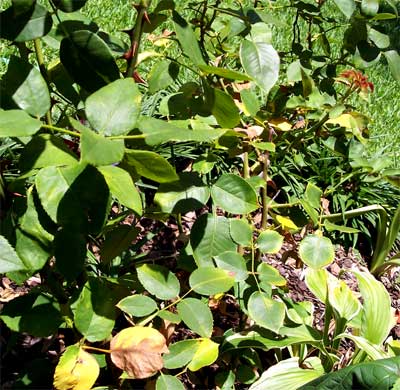
Answer: It looks like you plant might have gotten very dry at some point due to the fact that the lower leaves have yellowed and then browned. Either that, or it’s in an incredibly hot, reflective location. Some varieties just aren’t strong growers under abusive Texas soil and weather conditions. I agree that I don’t see any active black spot. I initially thought that might be possible, but now that I have seen the photo on a larger monitor, I’m with you. So, I don’t have a definite answer for you, but perhaps some direction you can be looking..
Question: What would cause this lighter yellow color on one branch of this oak tree? It is one tree, not two. I see other oaks doing the same thing. G.C., Dallas.
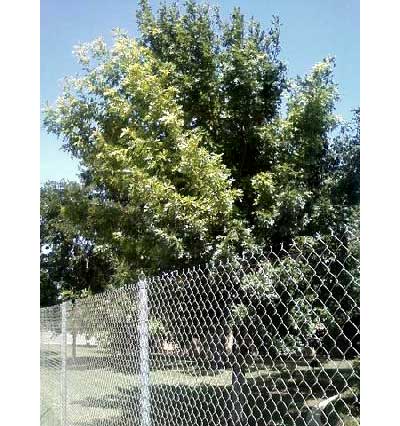
Answer: It’s difficult to see the leaves close enough to be sure, but this looks like iron deficiency. There are many red oaks in DFW that are not true Shumard red oaks, but either pin oaks or some hybrid type. Here is a link to information in my Most-Asked Questions section of our website.
Question: The bark on my 3-year-old live oak is splitting. What can I do to help the tree? C.S., University Park.
Answer: This really looks like sunscald, probably left over from the first year you had your tree. It doesn’t happen as often with live oaks as it does with Shumard red oaks, but it’s not unheard of. It results from the tree trunk’s having been exposed to hot, direct sunlight before the foliar canopy developed enough to shade it. At this point, about all you can do is wait to see if the tree can heal the wound. If it is still being hit by afternoon sun, applying paper tree wrap might help, but you’ll want to open it up every couple of months, to be sure insects and decay are not being harbored beneath the wrap. The canopy showing in your more distant photo looks like it’s holding onto its vigor.
Question: What is causing the strange brown spots again this year in my St. Augustine? They showed up in almost the same places last year. I’ve gotten a wide variety of guesses. J.J., Parker County.
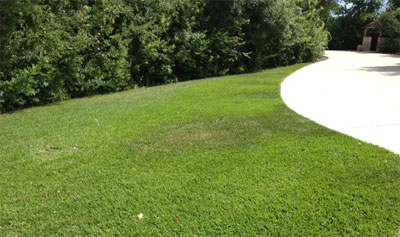
Answer: This is almost assuredly chinch bugs. Last year was a record-setter for them. They show up in the hottest, sunniest part of a lawn. (That matches in your photo.) Affected grass looks dry, but water doesn’t revive it. The centers of the yellowed area begin to die. If you part the grass on a hot afternoon, you’ll see the b-b-sized black insects with irregular white diamonds on their backs. The insecticide Merit (Imidocloprid) is a reliable control.
Question: What could be wrong with my live oak? It is in full sun, and it is watered every other day with our sprinkler system. The leaves yellow, and eventually they dry up and die. Other live oaks in the neighborhood look fine. Could it be iron deficiency? A.F., Tyler.
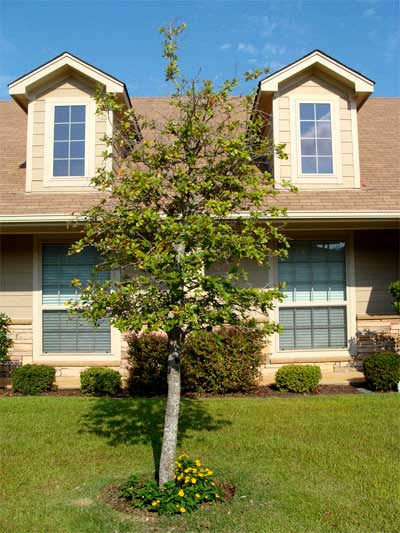
Answer: Live oaks won’t show iron deficiency, even in alkaline soils, unless there is some other calamity going on. As stout as this tree is, it has some type of trunk or root issue. It could be that it’s planted too deeply, or that there is insect or disease damage going on in the trunk. As much as I’d like to help, I can’t tell much more from this distance. However, my bet is that you may end up having to replace it. I hope I’m wrong. Do take into consideration the time that is passing as you invest more hopes in it. A new tree could be growing and becoming established.
Question: What kind of tree could we plant to replace one that died of cotton root rot last fall? Our landscaper suggested Chinese pistachio, but we’re unsure. What would you suggest? B. and S. M., McKinney.

Answer: If it were my landscape, and if I wanted a really large shade tree such as a Chinese pistachio, I might opt instead for Shumard red oak, bur oak or Chinquapin oak. All are virtually immune to cotton root rot. Chinese pistachio doesn’t appear to have a serious problem with the disease, either, but since it’s not native to Texas soils, I’d be concerned enough to bypass it in this specific location. And, from the "Unsolicited commentary" department, I might add to additional comments. First, your front yard isn’t huge, and these are all very large trees we are discussing. Eventually, you will not be able to grow grass beneath any of them, and they will pretty well "own" the entire area. Some people do consider trees that stay smaller at maturity, such as Little Gem magnolia. It, too, would be resistant to cotton root rot. Also, I would probably plant my new tree at ground level so that you wouldn’t ever have to contend with the raised bed, roots, watering issues, etc. That would also let the tree’s trunk (not the most attractive part of any shade tree) disappear into the grass more naturally. It’s never been my choice to showcase trunks, but that’s just one guy’s opinion..
Question: What is happening to my dwarf nandinas? I thought it was the heat and drought last summer, but it’s just as bad this year. They just don’t grow much. C., Austin.
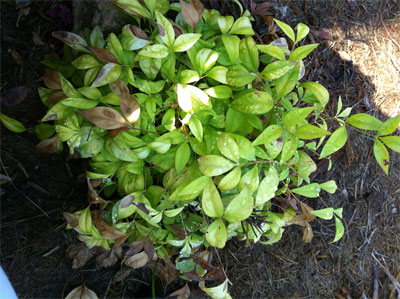
Answer: This is iron deficiency of Nana nandina (or one of its sisters). As you have, I also have alkaline soils where I garden, and these nandinas, as well as Gulf Stream and Moonbay, have always ended up looking like this in my landscape. You might try adding iron and sulfur soil acidifier to help correct the issue, but if it doesn’t help fairly quickly, switch over to Harbour Dwarf or one of its newcomer sisters. I’ve had better luck with them. The Nana types typically play out after 5 to 10 years.
Question: What type of grass would do well for me in Parker County? Can I plant it yet this summer? L.McM., Springtown.
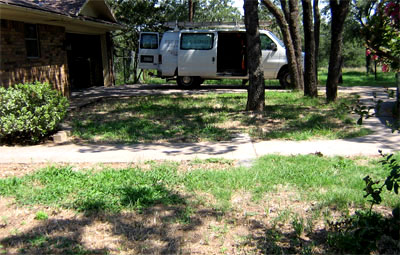
Answer: I can’t tell what type of grass is growing there now, but if it’s not St. Augustine, it might be an option. It tolerates shade much better than bermudagrass, but in the most heavily shaded areas, you’ll want to solid-sod it. Be sure it will receive 4 to 6 hours (or more!) of direct sunlight to ensure its success. Plant it as soon as possible, to give it as much time as possible to get established before fall and winter.
General Note on St. Augustine: In answering questions in the order in which they have been received, I’ve just come across several St. Augustine diagnostic questions. They are difficult to discern without being on-site. To that end, please let me refer you to the Most Asked Questions portion of my website. Scroll down to the last several questions in this stack, and you’ll find a great deal of help with St. Augustine issues. http://neilsperry.com/maq/lawns/
Question: What is wrong with my native rusty blackhaw viburnum? It happened several years ago following a wet spring. The worst affected part of the tree is the portion that’s exposed to the most direct hot sunlight. Is this sunscald? Dr. C.P., Keller.
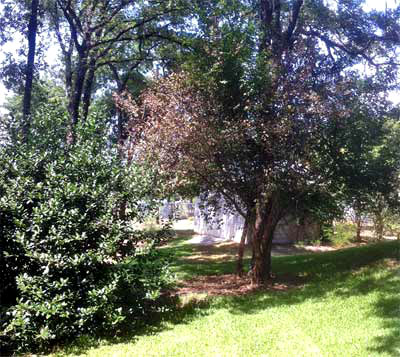
Answer: I planted a rusty blackhaw where a tree-form crape myrtle had begun to fail due to encroaching shade. The spot in my yard, for several years, was too shady for the crape myrtle, but too sunny for the viburnum. Now, it’s doing famously. Rusty blackhaw really does need shade, and my bet is that you have diagnosed the problem perfectly. I have never seen an insect or disease, either on any of the plants I have in my woods, or on the one I planted in my landscape.
Question: Does this appear to be a fungal problem with my new Shumard red oak? What can I use on it? Will it spread to other trees? E.G., no city given.
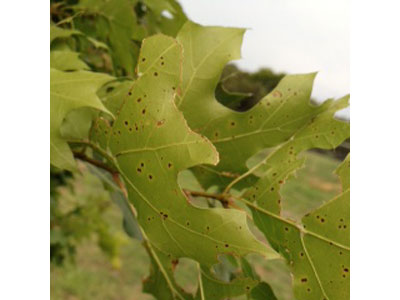
Answer: I wonder if this is a Shumard red oak. The leaves don’t look to be lobed quite right for true Shumard. If that’s the case, and if you have alkaline soils where you live (you didn’t mention the city), this could be, in part, due to iron deficiency. But, let’s assume this might be fungal. (It did look somewhat that way when I zoomed in on the photo.) I would apply Daconil or other labeled fungicide. It probably cropped up on the young tree’s tender new growth. Most likely it will not spread to other trees nearby. It’s probably already present all over the neighborhood, so if they were going to show it, they probably would already have done so.
Question: What can I use to keep caterpillars from ruining my coneflowers? U.K., McKinney.
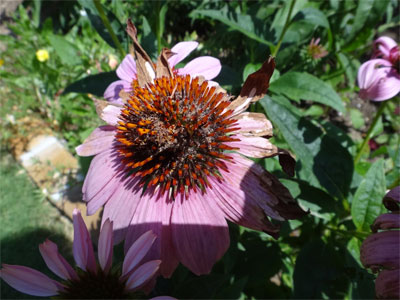
Answer: Apply a systemic insecticide soil drench in mid-April and again in mid-May. It will be taken in through the roots and up into the leaves and flowers.
Question: What can I do with this 35-year-old pony tail? It has gotten too tall. I know I need to repot it. P.J., Runaway Bay.
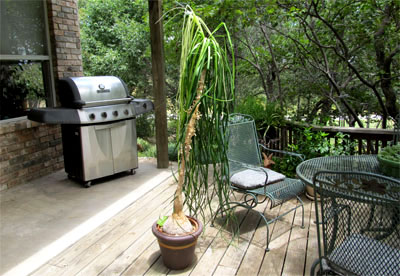
Answer: I have a pony tail that has been in our family 37 years, and I faced the same fate with it several years ago. Its old pot finally broke, and I was able to extract and repot it. I considered cutting its top out, to force it to send out several new side shoots, but I eventually decided to see what kind of growth it would make in its new, more spacious pot. I’ve been very pleased. Of course, pony tails are very large plants as they mature. It’s not uncommon to see old specimens that are 8 or 10 feet tall and 6 feet wide, and they can go beyond that. I guess my suggestion would be to go with it as long as you can. If necessary, you could try taking its top out to force the branching, or you could give it to a person or building who has adequate space for it.
Question: I am growing a "tribute fig" from a cutting taken from my late aunt’s tree in Mississippi. However, my tree gets rust really badly each year, and my limited research makes it look like there isn’t a really good control. Any suggestions? B.T., Fort Worth.
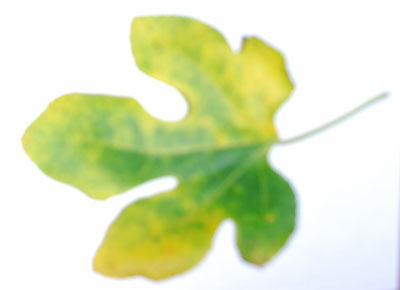
Answer: Here is a really good and complete write-up on figs from specialists at Texas A&M. Note that they do list copper fungicides as a control. They give special details of timing. I think this will help a great deal:
http://aggie-horticulture.tamu.edu/extension/homefruit/fig/fig.html
Question. What could have happened to my 10-year-old Shumard red oak? It looked fabulous on May 12. One month later, all the leaves were brown. Should I declare it lost? I hate to think so. Is there any chance it will leaf out next spring? M.R., Fort Worth
Answer: I’m stumped from the outset. The trunk looks fine, and the tree has obviously been hit by trauma. You detailed much more information in your note, and I’ve cut part of that out, but I agree that it certainly isn’t moisture-related. I saw your comments on the weedkiller possibility. Don’t assume, because there still are weeds, that no herbicide might have been used. Some of the weed-and-feed products are really toxic to shade trees, and perhaps enough of one of them could have gotten into the soil to do this serious damage. (Please see the magnolia question immediately below this one.) Otherwise, without any other clues, I would have to suggest you contact a certified arborist. However, they may end up telling you nothing more than what might have killed it — I doubt that they will be able to turn this tree around.
Question: Could you please tell me what is damaging my magnolia? I’ve had two arborists tell me it is drought damage. V.P., no city given.
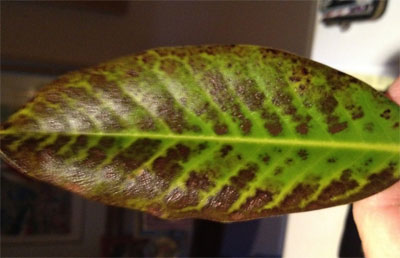
Answer: I’m going out on a limb on this one, and I hate to disagree with professional tree people. However, drought damage on southern magnolias typically shows up as marginal scorch — browning around the edges of the leaves. This, by comparison, looks exactly like what I’ve seen hundreds of times: damage done by the herbicide Atrazine, an active ingredient in a major brand of lawn weed-and-feed fertilizer. Think back to whether that might have been a possibility. It’s a product intended for St. Augustine lawns. In my 43 years in DFW, I’ve seen hundreds of magnolias damaged and killed by it. Enough so that I will not accept ads for any product containing it. Whether or not that’s the culprit, the symptoms surely do look similar. Affected trees’ leaves also often cup and roll in the process of the injury.
Question: How do I get rid of nutsedge? I’ve tried everything, and nothing works. S.C., Carrollton.
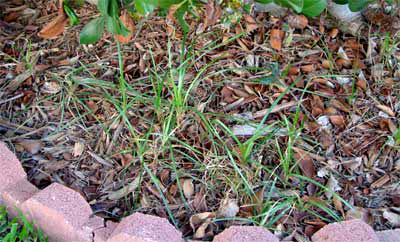
Answer: You apparently haven’t tried Image or Sedgehammer. Given time, both of these products will work effectively. Let a Texas Master Certified Nursery Professional guide you.
Question: We have this tough little weed in our landscape. Weedkillers seem to have had no effect. It is very wiry, and it has small white flowers. What can we do? G.C., Georgetown.
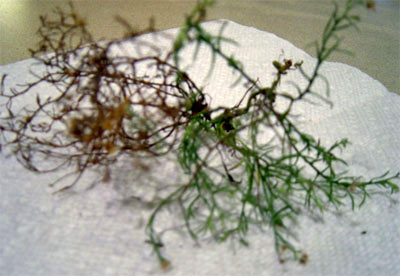
Answer: This is a common late-summer and fall weed, especially in areas where it’s difficult to get water and fertilizer. It’s roadside aster, and in spite of its tiny leaves, it’s classed as a "broadleafed" weed. Apply a product containing 2,4-d to eliminate it, but read and follow label directions regarding timing, method of application, and protection for plants nearby. When you’re able to step up the maintenance in this area, it will probably die away on its own.
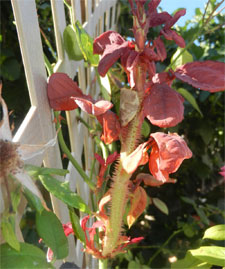
Question: Two years ago, I dug out a climbing rose that had rose rosette. I replaced it with another one in the same spot, and now it, too, has rosette. How long must I wait? Are some climbers more resistant than others? Should I plant other vines while I wait? S.P., Plano.
Answer: Rose rosette has become a very serious issue with rose growing in America. In all the reading I’ve done, I certainly haven’t seen a lot of encouragement for the issue once it hits a given garden. There may be resistant climbers, but there is a lot of research yet to be done in the meantime. If I were in your situation, I believe I’d be switching over to another type of vine for that spot. Use climbing roses somewhere fairly far removed.


